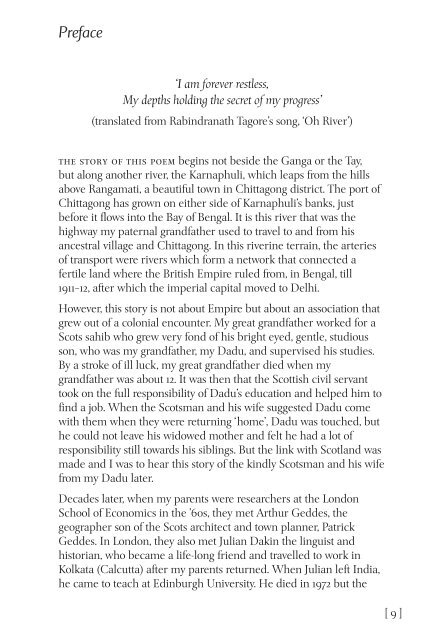From the Ganga to the Tay by Bashabi Fraser sampler
The Ganges and the Tay, the largest water courses in their two countries, are sources of life, conflict and industrial and historical change. The Ganga and the Tay is an epic concrete poem in which the River Ganges and the River Tay relate the historical importance of the ties between India and Scotland and their contemporary relevance as a natural symbol of continuity and peace. The poem is illustrated with beautiful photographs of both great rivers, which explore their shared, but unique, personalities through their histories, geographies, mythologies and environments.
The Ganges and the Tay, the largest water courses in their two countries, are sources of life, conflict and industrial and historical change. The Ganga and the Tay is an epic concrete poem in which the River Ganges and the River Tay relate the historical importance of the ties between India and Scotland and their contemporary relevance as a natural symbol of continuity and peace. The poem is illustrated with beautiful photographs of both great rivers, which explore their shared, but unique, personalities through their histories, geographies, mythologies and environments.
Create successful ePaper yourself
Turn your PDF publications into a flip-book with our unique Google optimized e-Paper software.
Preface<br />
‘I am forever restless,<br />
My depths holding <strong>the</strong> secret of my progress’<br />
(translated from Rabindranath Tagore’s song, ‘Oh River’)<br />
<strong>the</strong> s<strong>to</strong>ry of this poem begins not beside <strong>the</strong> <strong>Ganga</strong> or <strong>the</strong> <strong>Tay</strong>,<br />
but along ano<strong>the</strong>r river, <strong>the</strong> Karnaphuli, which leaps from <strong>the</strong> hills<br />
above Rangamati, a beautiful <strong>to</strong>wn in Chittagong district. The port of<br />
Chittagong has grown on ei<strong>the</strong>r side of Karnaphuli’s banks, just<br />
before it flows in<strong>to</strong> <strong>the</strong> Bay of Bengal. It is this river that was <strong>the</strong><br />
highway my paternal grandfa<strong>the</strong>r used <strong>to</strong> travel <strong>to</strong> and from his<br />
ancestral village and Chittagong. In this riverine terrain, <strong>the</strong> arteries<br />
of transport were rivers which form a network that connected a<br />
fertile land where <strong>the</strong> British Empire ruled from, in Bengal, till<br />
1911–12, after which <strong>the</strong> imperial capital moved <strong>to</strong> Delhi.<br />
However, this s<strong>to</strong>ry is not about Empire but about an association that<br />
grew out of a colonial encounter. My great grandfa<strong>the</strong>r worked for a<br />
Scots sahib who grew very fond of his bright eyed, gentle, studious<br />
son, who was my grandfa<strong>the</strong>r, my Dadu, and supervised his studies.<br />
By a stroke of ill luck, my great grandfa<strong>the</strong>r died when my<br />
grandfa<strong>the</strong>r was about 12. It was <strong>the</strong>n that <strong>the</strong> Scottish civil servant<br />
<strong>to</strong>ok on <strong>the</strong> full responsibility of Dadu’s education and helped him <strong>to</strong><br />
find a job. When <strong>the</strong> Scotsman and his wife suggested Dadu come<br />
with <strong>the</strong>m when <strong>the</strong>y were returning ‘home’, Dadu was <strong>to</strong>uched, but<br />
he could not leave his widowed mo<strong>the</strong>r and felt he had a lot of<br />
responsibility still <strong>to</strong>wards his siblings. But <strong>the</strong> link with Scotland was<br />
made and I was <strong>to</strong> hear this s<strong>to</strong>ry of <strong>the</strong> kindly Scotsman and his wife<br />
from my Dadu later.<br />
Decades later, when my parents were researchers at <strong>the</strong> London<br />
School of Economics in <strong>the</strong> ’60s, <strong>the</strong>y met Arthur Geddes, <strong>the</strong><br />
geographer son of <strong>the</strong> Scots architect and <strong>to</strong>wn planner, Patrick<br />
Geddes. In London, <strong>the</strong>y also met Julian Dakin <strong>the</strong> linguist and<br />
his<strong>to</strong>rian, who became a life-long friend and travelled <strong>to</strong> work in<br />
Kolkata (Calcutta) after my parents returned. When Julian left India,<br />
he came <strong>to</strong> teach at Edinburgh University. He died in 1972 but <strong>the</strong><br />
[ 9 ]


















